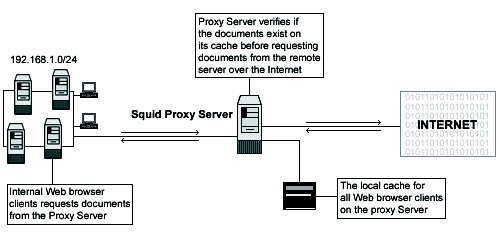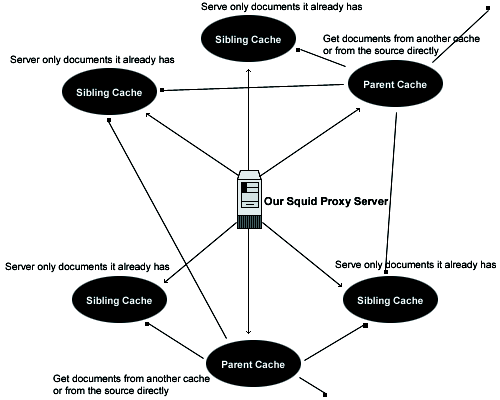28.7. Configure of the /etc/squid/squid.conf file -/proxy-caching mode
With some minor modification to the squid.conf file we have defined above to run in httpd-accelerator mode, we can run Squid as a proxy-caching server. With a proxy cache server, all users in your corporate network use Squid to access the Internet. With this configuration, you can have complete control, and apply special policies on what can be viewed, accessed, and downloaded. You can also control bandwidth usage, connection time, and so on. A proxy cache server can be configured to run as stand-alone server for your corporation, or to use and share caches hierarchically with other proxy servers around the Internet.

With the first example below we show you how to configure Squid as a stand-alone server, and then speak a little bit about a cache hierarchy configuration, where two or more proxy-cache servers cooperate by serving documents to each other. Edit the squid.conf file, vi /etc/squid/squid.conf and add/change the following options for proxy cache that run as a stand-alone server:
http_port 8080
icp_port 0
acl QUERY urlpath_regex cgi-bin \?
no_cache deny QUERY
cache_mem 16 MB
cache_dir ufs /cache 200 16 256
redirect_rewrites_host_header off
replacement_policy GDSF
acl localnet src 192.168.1.0/255.255.255.0
acl localhost src 127.0.0.1/255.255.255.255
acl Safe_ports port 80 443 210 119 70 21 1025-65535
acl CONNECT method CONNECT
acl all src 0.0.0.0/0.0.0.0
http_access allow localnet
http_access allow localhost
http_access deny !Safe_ports
http_access deny CONNECT
http_access deny all
cache_mgr admin@openna.com
cache_effective_user squid
cache_effective_group squid
log_icp_queries off
cachemgr_passwd my-secret-pass all
buffered_logs on
|
The big difference with the httpd-accellerator mode configuration is the use of access control lists (ACL). This feature allows you to restrict access based on source IP address (src), destination IP address (dst), source domain, destination domain, time, and so on. Many types exist with this feature, and you should consult the Squid.conf file for a complete list. The four most used types are as follows:
acl name type data
| | | |
acl some-name src a.b.c.d/e.f.g.h # ACL restrict access based on source IP address
acl some-name dst a.b.c.d/e.f.g.h # ACL restrict access based on destination IP address
acl some-name srcdomain foo.com # ACL restrict access based on source domain
acl some-name dstdomain foo.com # ACL restrict access based on destination domain
As an example, to restrict access to your Squid proxy server to only your internal clients, and to a specific range of designated ports, something like the following will make the job:
acl localnet src 192.168.1.0/255.255.255.0
acl localhost src 127.0.0.1/255.255.255.255
acl Safe_ports port 80 443 210 119 70 21 1025-65535
acl CONNECT method CONNECT
acl all src 0.0.0.0/0.0.0.0
http_access allow localnet
http_access allow localhost
http_access deny !Safe_ports
http_access deny CONNECT
http_access deny all
|
This acl configuration will allow all internal clients from the private class C 192.168.1.0 to access the proxy server; it's also recommended that you allow the localhost IP (a special IP address used by your own server) to access the proxy. After we choose a range of ports (80=http, 443=https, 210=wais, 119=nntp, 70=gopher, and 21=ftp) which our internal clients can use to access the Internet, we deny the CONNECT method to prevent outside people from trying to connect to the proxy server, and finally, we deny all source IP address and ports on the proxy server.
: A good strategy to avoid generating more network traffic than without web caching is to choose to have several sibling caches and only a small number of parent caches.
